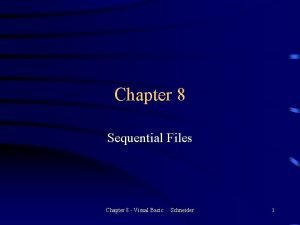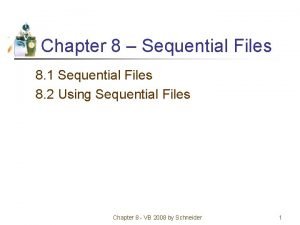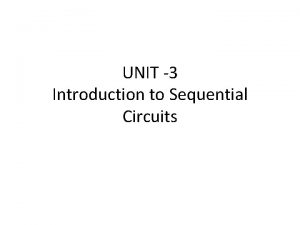Introduction to Java Files Text Files A sequential













- Slides: 13

Introduction to Java Files

Text Files • A sequential collection of data stored on a permanent storage device • Hard drive • USB memory • CD/DVD • Has a name and location on computer’s file system … John 9 87 book 77. 9 44 course Current position …

File Operations • Open – Locate the file on computer’s file system – Position the read/write head at the beginning of the file • Current position = beginning of the file … Current position John 9 87 book 77. 9 44 course …

File Operations • Open for input (reading) … John 9 87 book 77. 9 44 course … Current position • Open for output (writing) – If the file already exists, erase the file content Current position

File Operations • Read – At the current position … John 9 87 book 77. 9 44 course Current position – Read next string • Returns book – Read next integer • Error (next piece of data is not integer) …

File Operations -- rules • Open for input – The file must exist on the computer’s file system • Error otherwise • Open for output – If the file already exists, its content is erased • Read – The type of the data item at current position should match the type of read instruction (i. e. next. Int, next. Double, …) • Error otherwise – Trying to read past the last piece of data (beyond end of file)will result in an error • Write – Must close the file at the end so that it will be written back to the operating system’s file system

File Operations -- Java • Open for input – The file must exist on the computer’s file system • Error otherwise String file. Name= "my. File. txt"; File inp. File = new File(file. Name); Scanner in = new Scanner(inp. File); • Error if "my. File. txt“ does not exist in the project folder

File Operations -- rules • Open for output – If the file already exists, its content is erased String file. Name= "my. File. txt"; Print. Writer out. File = new Print. Writer(file. Name); – "my. File. txt“ will be erased, if it already exists.

File Operations -- rules • Read – The type of the data item at current position should match the type of read instruction (i. e. next. Int, next. Double, …) • Error otherwise – inp. File. next(); » returns the next piece of data in the file as a string – inp. File. next. Int(); – returns the next piece of data in the file as an Integer. The next piece of data in the file must be an integer. – inp. File. next. Double » returns the next piece of data in the file as a Double. The next piece of data in the file must be a Double.

File Operations -- rules • Read – Must ensure that we do not attempt to read beyond the last piece of data in the file – inp. File. has. Next();

File Operations -- rules • Write – Must close the file at the end so that it will be written back to the operating system’s file system • Similar to a scanner – out. File. print(); – out. File. println(); – out. File. printf(); » See section 4. 3. 2 of the text book » See http: //web. cerritos. edu/jwilson/Site. Pages/java_language _resources/Java_printf_method_quick_reference. pdf

File Operations -- rules • Close – out. File. close();

File Operations -- rules • Method that use file operations must have throws IOException in their headers
 File mode python
File mode python Cjis training
Cjis training Ncic hosts restricted files and non-restricted files
Ncic hosts restricted files and non-restricted files Text to text text to self text to world
Text to text text to self text to world Types of file organization
Types of file organization Outline steps to be taken when creating a sequential file
Outline steps to be taken when creating a sequential file Sequential files in vb
Sequential files in vb Sequential search in c
Sequential search in c Sequential search java
Sequential search java Sequential text structure
Sequential text structure D flip flop truth table
D flip flop truth table Java swing form example
Java swing form example Java import java.util.*
Java import java.util.* Swing vs awt
Swing vs awt
























